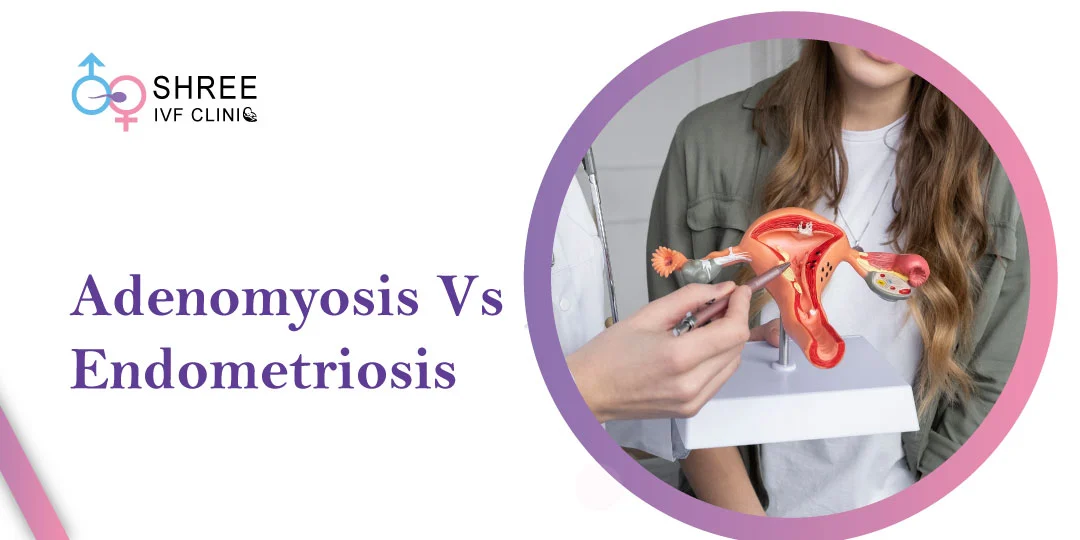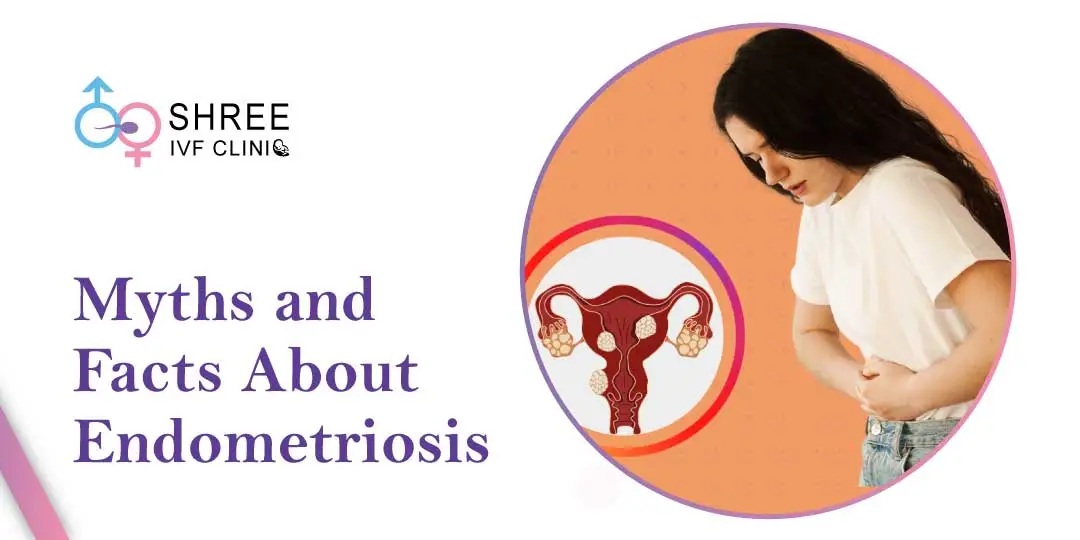Endometriosis vs. Adenomyosis : Differences, Symptoms, Diagnosis , Treatment Options
UPDATED ON 14 FEB. 2025
Every woman’s health journey is unique, and knowledge is a powerful tool in navigating it. In this light, understanding conditions like adenomyosis and endometriosis becomes crucial.
These conditions may seem similar but have distinctive features that set them apart. This guide sheds light on these two conditions, helping you understand their differences, symptoms, causes, and treatments.

AUTHOR
Dr Jay Mehta
Scientific Director & IVF Specialist with 10+ years of experience
GET IN TOUCH ON
What are Adenomyosis and Endometriosis?
Adenomyosis is a condition where the inner lining of the uterus (endometrium) breaks through the muscle wall of the uterus (myometrium).
This can cause menstrual cramps, lower abdominal pressure, and bloating before menstrual periods and can result in heavy periods. The condition is often confused with fibroids, another type of benign tumor of the uterus, due to their similar symptoms.
On the other hand, endometriosis is a disorder where the tissue that forms the lining of your uterus grows outside of your uterine cavity.
The most common locations of endometrial growth are the ovaries, fallopian tubes, and tissues lining your pelvis. Unlike adenomyosis, endometriosis can spread to other parts of the body. This condition can cause pain—sometimes severe—especially during your period.
Key Differences Between Adenomyosis and Endometriosis
| Feature | Adenomyosis | Endometriosis |
|---|---|---|
| Location | Inside the uterine wall | Outside the uterus |
| Pain | Heavy, crampy periods, tender uterus | Painful periods, pain during sex or movement |
| Impact on size | Enlarged, bulky uterus | No change in uterus size |
| Effect on fertility | Rarely causes infertility | Often linked to infertility |
| Who gets it? | More common in women over 40 | Can affect women of any age |
Unveiling the Causes and Risk Factors
While the exact causes of adenomyosis and endometriosis remain unclear, factors like hormonal changes, immune system disorders, and genetics may play a role.
For adenomyosis, middle-aged women and those who’ve had children are seen to be at a higher risk. It is believed that childbirth might cause the endometrial tissue to break into the myometrium. Women who’ve had uterine surgery may also be at risk.
For endometriosis, it can affect any woman of reproductive age, irrespective of whether they’ve had children or not. Factors like a family history of the disease, menstrual cycle irregularities, and certain lifestyle factors may increase the risk.
Read More: Understanding Adenomyosis of the Uterus
Identifying the Signs and Symptoms
Both adenomyosis and endometriosis share some common symptoms, including painful and heavy periods and discomfort during intercourse. However, the symptoms can vary depending on the location and extent of tissue growth.
Adenomyosis may lead to an enlarged uterus, making it tender and causing severe abdominal pain. Women with adenomyosis might also experience a prolonged menstrual cycle and spotting between periods.
Endometriosis can sometimes cause painful bowel movements or urination, especially during menstruation. Other symptoms include chronic pelvic pain, fatigue, and even gastrointestinal issues like diarrhea, constipation, and bloating.
If you or someone you know is struggling with symptoms like heavy periods, severe cramps, or fertility issues, don’t hesitate to consult a gynecologist. The right diagnosis and treatment can make a huge difference.
Diagnosis and Medical Evaluation
Diagnosing adenomyosis and endometriosis can be challenging due to their overlapping symptoms with other conditions. For adenomyosis, gynaecologists often use ultrasound or MRI scans to diagnose the condition. Sometimes, a biopsy may be needed to confirm the diagnosis.
Regarding endometriosis, laparoscopy is the most common diagnostic procedure, where a surgeon visually examines the abdominal cavity with a special viewing instrument. A biopsy of the suspicious tissue can also be taken during this procedure for further examination.
The Impact on Fertility
Both adenomyosis and endometriosis can affect a woman’s fertility, but it doesn’t mean that getting pregnant is impossible. Adenomyosis can distort the uterine cavity, making implantation difficult.
On the other hand, endometriosis can cause inflammation and scarring, potentially affecting egg production and transportation.
However, many women with these conditions have successfully conceived with appropriate treatment and care. Assisted reproductive technologies like In-vitro fertilization (IVF) have also made it possible for women with these conditions to become mothers.
Exploring Treatment Options
Hormonal therapies can help regulate the menstrual cycle and reduce symptoms. In severe cases, a hysterectomy, the surgical removal of the uterus, might be recommended.
Endometriosis treatment options also include pain medication, hormonal therapies, and surgery, depending on the severity and the patient’s plans for pregnancy.
Conservative surgery can remove endometrial growths while preserving fertility. For women who do not wish to conceive, a hysterectomy with removal of the ovaries may be considered.
Management Strategies
Leading a balanced lifestyle can help manage both conditions. Regular exercise, a healthy diet, adequate sleep, and stress management are beneficial. For those with endometriosis, warm baths and a heating pad can also help alleviate pain.
Alternative therapies like acupuncture and yoga have also shown to provide relief for some women. Remembering that what works for one person may not work for another is important. Therefore, it’s essential to have open discussions with your gynecologist to find the best management strategy for you.
Conclusion
Understanding adenomyosis and endometriosis is the first step towards managing these conditions effectively. While they share similarities, their differences are significant, from their nature to their impact on fertility.
Remember, every woman’s health journey is unique, so it’s vital to seek advice from experienced gynecologists for personalized care. Trust Dr. Jay Mehta at Shree IVF Clinic for expert endometriosis treatment in Mumbai, India. Take charge of your health; schedule a consultation now. Your health is your wealth, and understanding your body is the first step to preserving it.
AUTHOR
Dr Jay Mehta
Scientific Director & IVF Specialist with 10+ years of experience
CALL US 24/7 FOR ANY HELP
GET IN TOUCH ON
Share Article on
Recommended Reading
Chances of Getting Pregnant with Endometriosis?
Endometriosis doesn’t always mean infertility. Around 70% of women with minimal to moderate stages conceive without fertility treatment
Myths and Facts About Endometriosis: All You Need to Know
Endometriosis myths can confuse treatment. It’s more than bad cramps, and many women still conceive. Learn the truth and get informed
Can Endometriosis Come Back After Surgery?
Endometriosis may return after surgery, as there’s no guaranteed way to stop it completely. But you can take steps to stay aware and support your health.




